In case you were in any doubt, we are now living in the creator economy.
Content creators, influencers, and community builders now wield more power than ever before and have the ability to earn revenue from their craft in many different ways.
But that doesn’t mean it’s easy.
Content creators – whether they’re bloggers, videographers, photographers, or some other kind of creative – are constantly on the hunt for new and effective ways to monetize their work within a volatile digital landscape.
Display ad networks are a tried-and-tested method to do just that – and choosing the right one can help publishers maximize their earnings while delivering a great user experience.
In this article, we’ll explore the best ad networks for content creators in 2024, giving you the right tools to monetize your content effectively.
What Is An Ad Network?
Let’s start, as always, with the basics: What is an ad network?
An ad network is a platform that acts as a middleman between publishers (i.e., bloggers, content creators, etc.) who want to sell ad space on their websites or platforms and advertisers looking to purchase ad placements.
Ad networks serve as a bridge to help advertisers find ad placements on websites that align with their target consumers and goals – and vice versa. They help publishers connect with advertisers whose ads align with their own content and audience.
For bloggers and content creators, ad networks provide an opportunity to make money from their content without having to negotiate directly with advertisers.
As opposed to using sponsored posts or affiliate marketing deals, ad networks represent a more automated, hands-off option that removes a lot of manual work – saving creators time and stress.
Here’s how ad networks typically function, though this can differ depending on the type of ad network you decide to work with.
- The publisher joins the network – This is the first step and usually requires you to submit your content or site for review. Often, ad networks will have a minimum traffic requirement for you to join. Once the network has assessed whether your content fits its criteria (e.g., content quality, niche, traffic, etc.), it will make a decision on whether to approve you.
- Ad placement – Once you’ve been approved, you’ll the process of getting ads placed on your site. This process will differ depending on which network you use. Sometimes, it’s as simple as getting a code snippet that you then embed on your site. Other times, you will share your available inventory and have advertisers send you bids for placements. The ultimate outcome is that the ad network will enable you to place ads on your site or content that resonate with your audience and drive clicks and impressions.
- Earnings generations – Advertisers pay the ad network to serve their ads, and when users see those ads on your site and click or view them, you earn money. How much money you earn depends on how the network pays.
- Payment – The ad network then pays you your earnings through whatever method you choose. Sometimes, they’ll take a commission, which will vary depending on the network.
What Are The Different Types Of Ad Networks?
While the types of ad networks out there are always evolving and changing, here are some of the different types you might come across.
Vertical Networks
These are networks that specialize in specific niches or industries. Their purpose is to help advertisers in the said industry reach a highly targeted audience.
For example, you might find a vertical network that only serves ads related to ecommerce or finance, and this would be a good fit for a creator whose content aligns with those topics.
Premium Networks
These are networks that emphasize high-quality ad content. They’ll often work with first-rate publishers and creators, or websites that generate a ton of traffic. Why? Because some advertisers are more likely to spend the big bucks to place their ads on sought-after sites.
Specialized Or Inventory-Specific Networks
Sound a lot like vertical networks? That’s because they are.
The main differentiator here is that specialized networks can be focused on the type of content rather than the industry. Think: A video-specific network or one that only serves ads within podcasts.
Targeted Networks
Advertisers that want to reach a hyper-specific demographic or segment or users might leverage a targeted network. They focus on very particular targeting based on a range of criteria, like location, user behavior, etc.
Performance And Affiliate Ad Networks
These networks are more concerned with user actions than just displaying ads.
In these cases, advertisers will pay publishers when the user takes a specific action on their advertising content – whether that’s signing up, registering for something, making a purchase, etc. This goes for affiliate ad networks, too, where creators make commissions for purchases made using their affiliate links.
How To Choose The Ad Network That’s Best For You
Ad networks are one of the easiest and most recognizable ways to generate income as a content creator, so it’s no surprise that there are many of them to choose from.
That said, not all ad networks are created equal, and not all of them will be a good fit for your content, audience, and goals.
There are a handful of things you should consider when choosing the right ad network:
- Audience and Niche – As a content creator, you should understand your audience and content niche deeply. Some ad networks will cater to specific industries or areas and user demographics. Do your research and make sure that the network and its advertisers align well with your audience and niche.
- Ad formats – Different ad networks offer very different ad types, sizes, and placements. You should think about which ones you are most interested in using and why, then seek out an ad network that offers those options.
- Revenue models – Take the time to understand the different payment models used by ad networks and which one works best for you. Some offer a revenue share model, and others offer a cost-per-mille (CPM) or cost-per-click (CPC) model. Some work off a cost-per-action (CPA) model. Some offer all of the above! Choose whatever makes the most sense for you.
- Traffic requirements – Many ad networks will have a minimum traffic requirement in order to join. This means that you will not be able to use the ad network unless your site or platform gets a certain number of visits each month. In this way, some ad networks are a better fit for small publishers, while others are better for high-traffic creators.
- User experience – This is perhaps the most important consideration of all. As a content creator, your user experience is crucial to your success. Be sure to investigate how each ad network approaches the user experience and prioritize those that emphasize serving relevant ads that are non-intrusive. Your audience will appreciate it, and you will see more revenue.
17 Best Ad Networks For Content Creators In 2024
1. Google AdSense
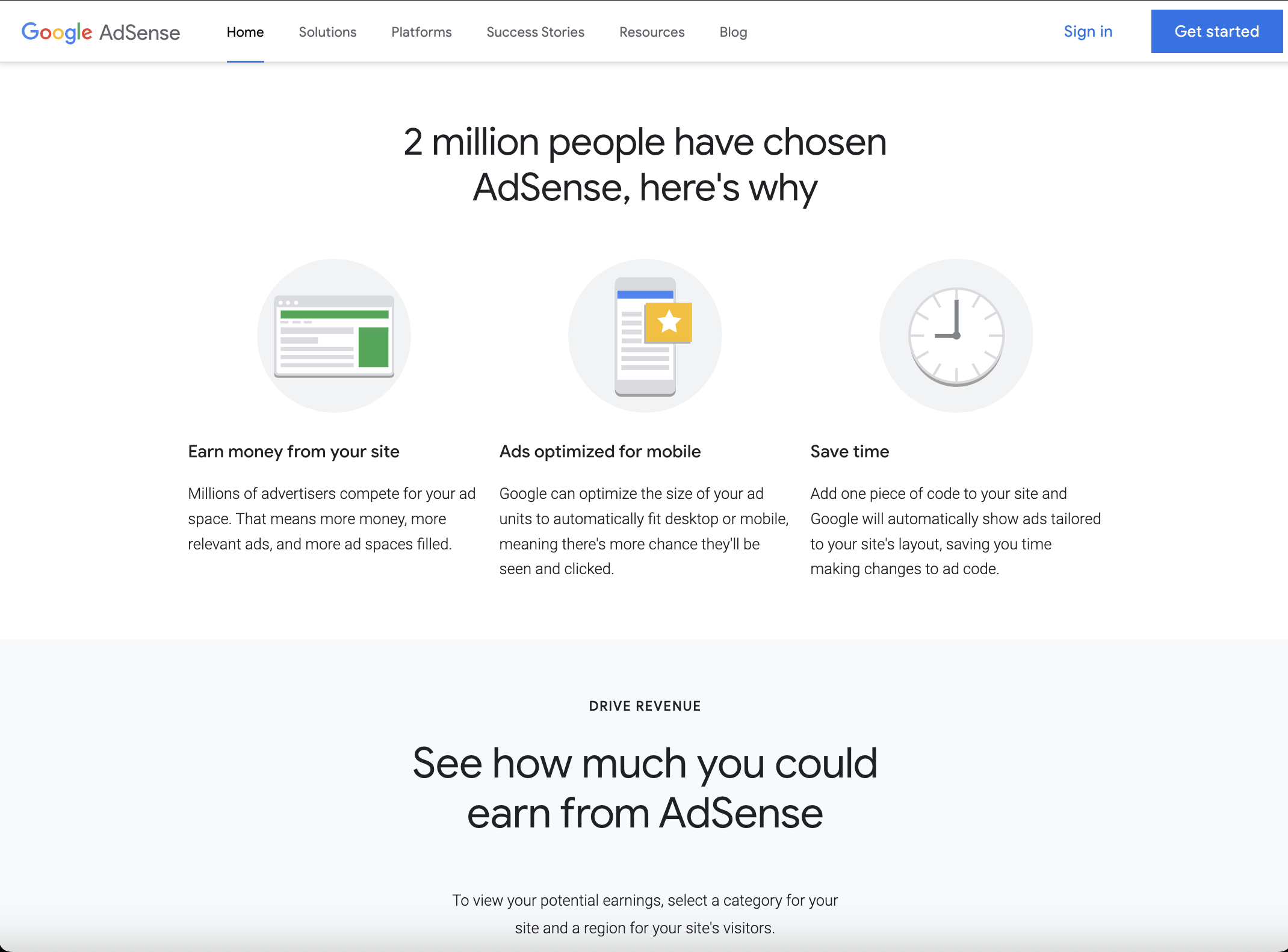 Screenshot from GoogleAdsense, October 2023
Screenshot from GoogleAdsense, October 2023If you’re just getting started in the world of ad monetization, Google AdSense is a great pick. Owned by Google, it’s one of the most popular ad networks thanks to its ease of use – hence why it’s a great choice for beginners.
There’s no minimum traffic requirement, and the self-service platform is free to join.
Once you’re approved, you can start displaying ads by just embedding a snippet of code into your site. The Auto Ads feature makes it extremely easy to automatically place ads on your website or switch them off for specific pages.
Google AdSense offers a bunch of different ad formats, including display, text, in-feed, and in-article ads, and personalization options like contextual and behavioral targeting.
But the platform also has its challenges. Getting approved is not always easy due to Google’s strict policies and guidelines – and even once approved, you risk account suspension for any violations.
In order to withdraw your earnings, you need to earn at least $100. And while you can earn some decent money from AdSense, the revenue potential isn’t as promising as some other platforms.
Revenue share: 68% to site owners / 32% to Google AdSense.
Payment model: CPC.
Traffic requirements: None.
Key features:
- Responsive ads – With AdSense, your ad units can be automatically sized to fit the user’s device, ensuring a great user experience.
- Insights and analytics – Detailed performance reports help you get information on how your ads are performing so that you can optimize your placements. Metrics you can track include views, clicks, revenue, and more.
- Ad review center – Control what ads appear on your site with the ability to review and then approve or deny specific ad categories.
2. Media.net
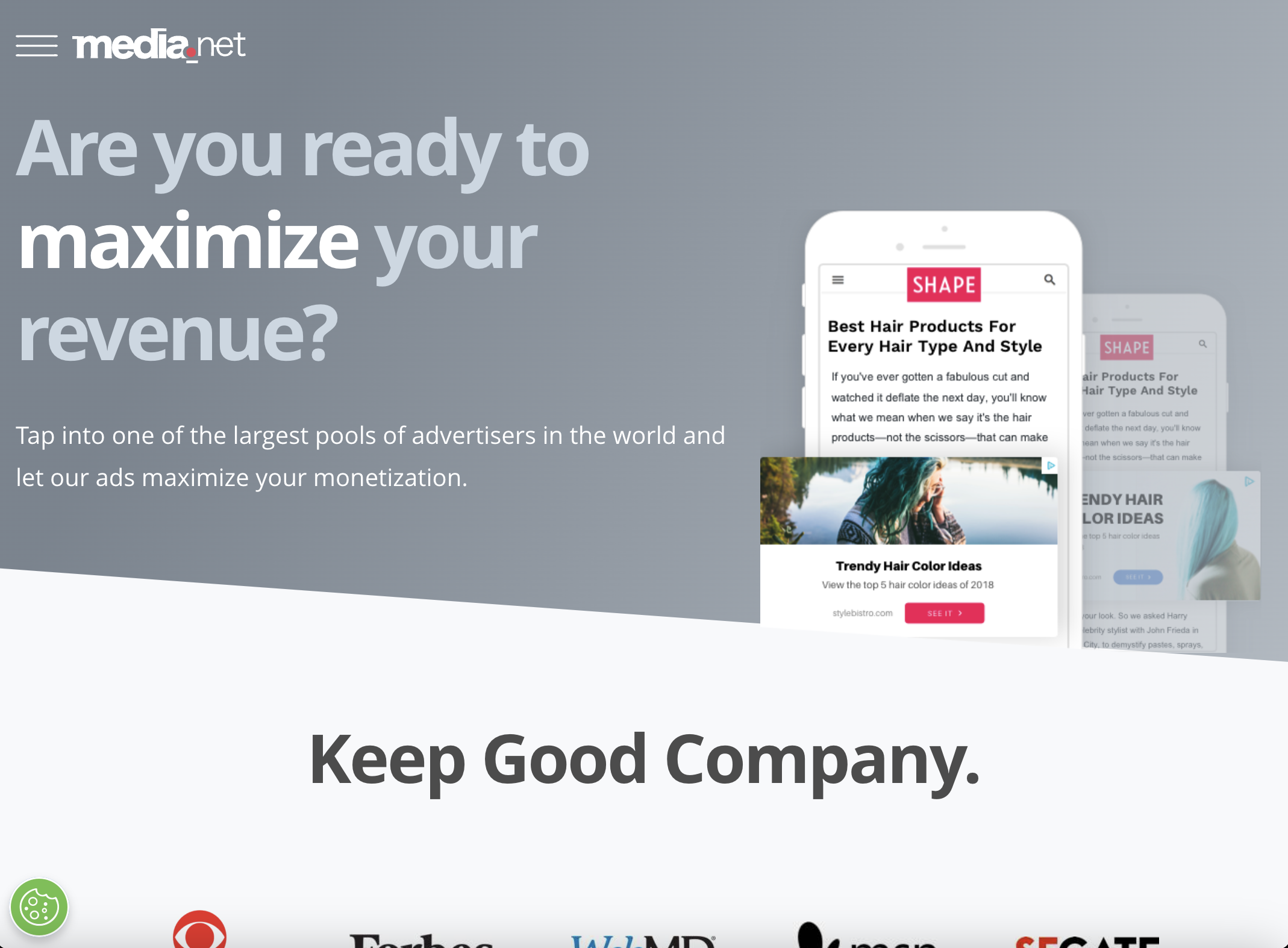 Screenshot from media.net, October 2023
Screenshot from media.net, October 2023If you’re looking for an alternative to Google AdSense, look no further than Media.net. It’s powered by Yahoo! and Bing, providing an impressive pool of advertisers and making it a great choice to supplement your AdSense efforts.
Media.net is best known for its focus on contextual ads. This means that rather than serving ads to your audience based on their interests, it displays ads that are closely related to the content on your page – which is believed to increase user engagement and clickthrough rates (CTRs).
For example, if your blog post is about beautiful beaches, Media.net might serve your users ads about beach towels.
Similar to AdSense, Media.net is free and has no traffic requirement to join. It offers an expansive inventory of ads, and its ads are optimized for viewing on mobile devices.
Media.net also assists publishers and creators via dedicated account managers who can help you with setup, issue troubleshooting, and optimization tips, giving it a significant edge over many other platforms.
Downsides to be aware of are a somewhat challenging approval process, a learning curve, a minimum payout threshold of $100, and the fact that payment options are limited to Payoneer or wire transfer.
It’s also worth noting that Media.net tends to perform best for sites in specific niches such as health, tech, and finance. If your site is outside of these niches, you may experience lower earnings than on other platforms.
Revenue share: Undisclosed.
Payment model: CPC, CPM.
Traffic requirements: None.
Key features:
- Dynamic optimization – In order to get the most bang for your impressions, Media.net will optimize between the ad types that it believes will perform best with your audience.
- Sizeless ads – Media.net allows publishers to create ads with totally custom sizes and designs if they’d like in order to fit their site.
- “Sticky” ads – The platform offers ads that stick to the screen as your users scroll – or in-content ads that are displayed automatically within your content – to improve viewability.
3. Raptive (Formerly AdThrive)
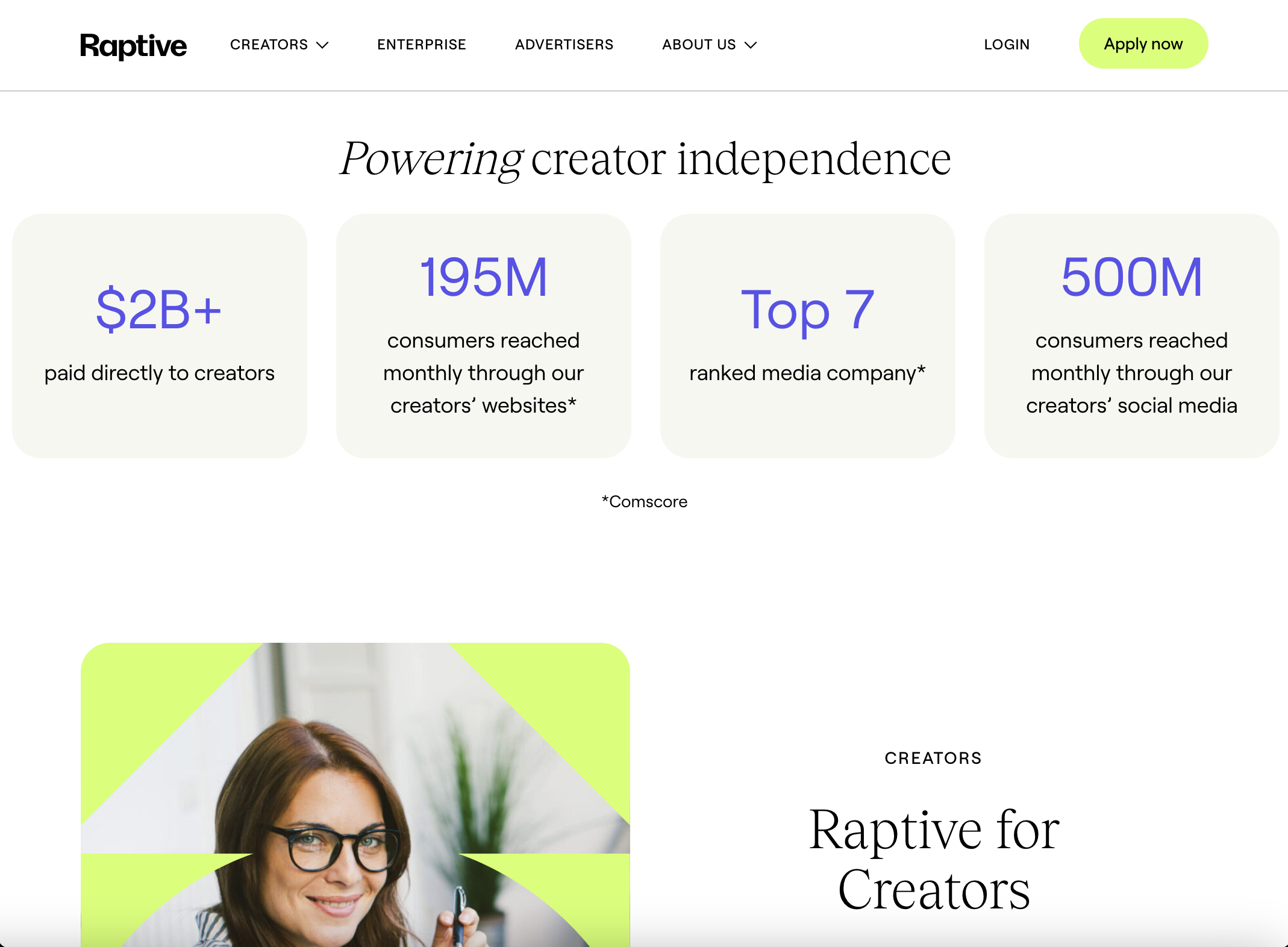 Screenshot from Raptive, October 2023
Screenshot from Raptive, October 2023Raptive, formerly known as AdThrive, is thought to be one of the most sought-after ad networks for content creators, especially those who operate in the travel, lifestyle, food, and parenting niches.
It has a reputation for driving impressive revenue growth for websites by optimizing ad placements and performance. It also has a reputation for putting publishers first, so creators will get paid regardless of whether Raptive is paid by its advertisers.
Other pros of Raptive include a dedicated support team to help creators, flexible payment options, personalized recommendations for your site, the ability to host and monetize video content, and a user-friendly dashboard that provides insights into your earnings and impressions.
But as with all things, there are also some drawbacks.
First and foremost, Raptive has a high barrier to entry; you need to have at least 100,000 pageviews in order to qualify for its minimum traffic requirements. This can be challenging for new or smaller creators.
Additionally, it primarily caters to English content, and you need to have a majority of your traffic come from the US, CA, UK, AU, or NZ. There are some reports that Raptive can have a high ad density (i.e., serve a lot of ad placements), and you will need to consider this aspect of your user’s experience.
Revenue share: 75% to site owners / 25% to AdThrive.
Payment model: CPC.
Traffic requirements: 100,000 pageviews per month.
Key features:
- Auto ad placement – Ads will be automatically placed in the positions where they will perform best by Raptive’s algorithms.
- Experimentation – Creators can test out a variety of different ad types and placements with Raptive’s customizable A/B ad testing.
- Learning resources – Raptive offers a selection of expert webinars, tutorials, and articles to help creators boost their earnings.
4. Adcash
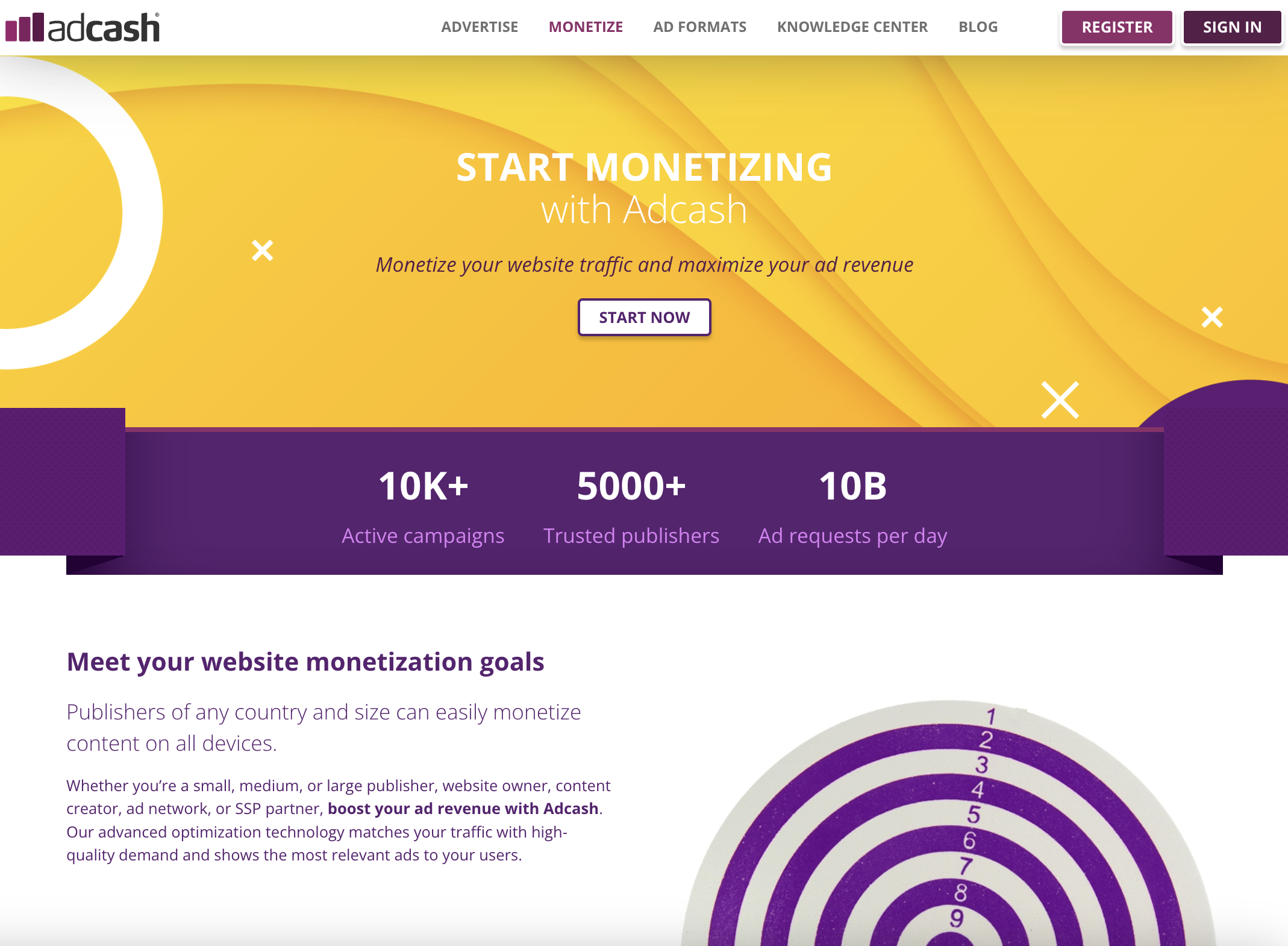 Screenshot from Adcash, October 2023
Screenshot from Adcash, October 2023Adcash is a self-serve ad network catering to both creators and advertisers serving a global audience.
It’s known for its vast range of traffic sources and ad formats, which include options like pop-under, native ads, interstitials, display ads, banners, push notifications, and more.
Its global approach means content creators can reach users in more than 196 countries – and this flexibility is worth noting.
Additional pros of Adcash include access to real-time performance reporting, optimization tools, and – perhaps most interestingly – its anti-adblock technology, which allows creators to continue generating revenue from website visitors who are using ad-blocking tools.
Adcash offers multiple payment options and is fairly easy to set up and get started with.
Potential drawbacks of Adcash include a possible negative impact on the user experience from some ad formats (such as interstitials or pop-unders), a minimum payment threshold of $25 USD/EUR, and lower CPM rates than the market average.
Revenue share: Undisclosed.
Payment model: CPC, CPM, CPA, RevShare, dynamic CPM.
Traffic requirements: None.
Key features:
- Anti-Adblock technology – The ability to show ads to users, even if they’re using an ad-block tool.
- High fill rate – Consistently high fill rates mean you can monetize more impressions.
- Live reporting – The Publisher Platform Reports section in Adcash helps you track revenue as it rolls in.
5. Amazon Publisher Services
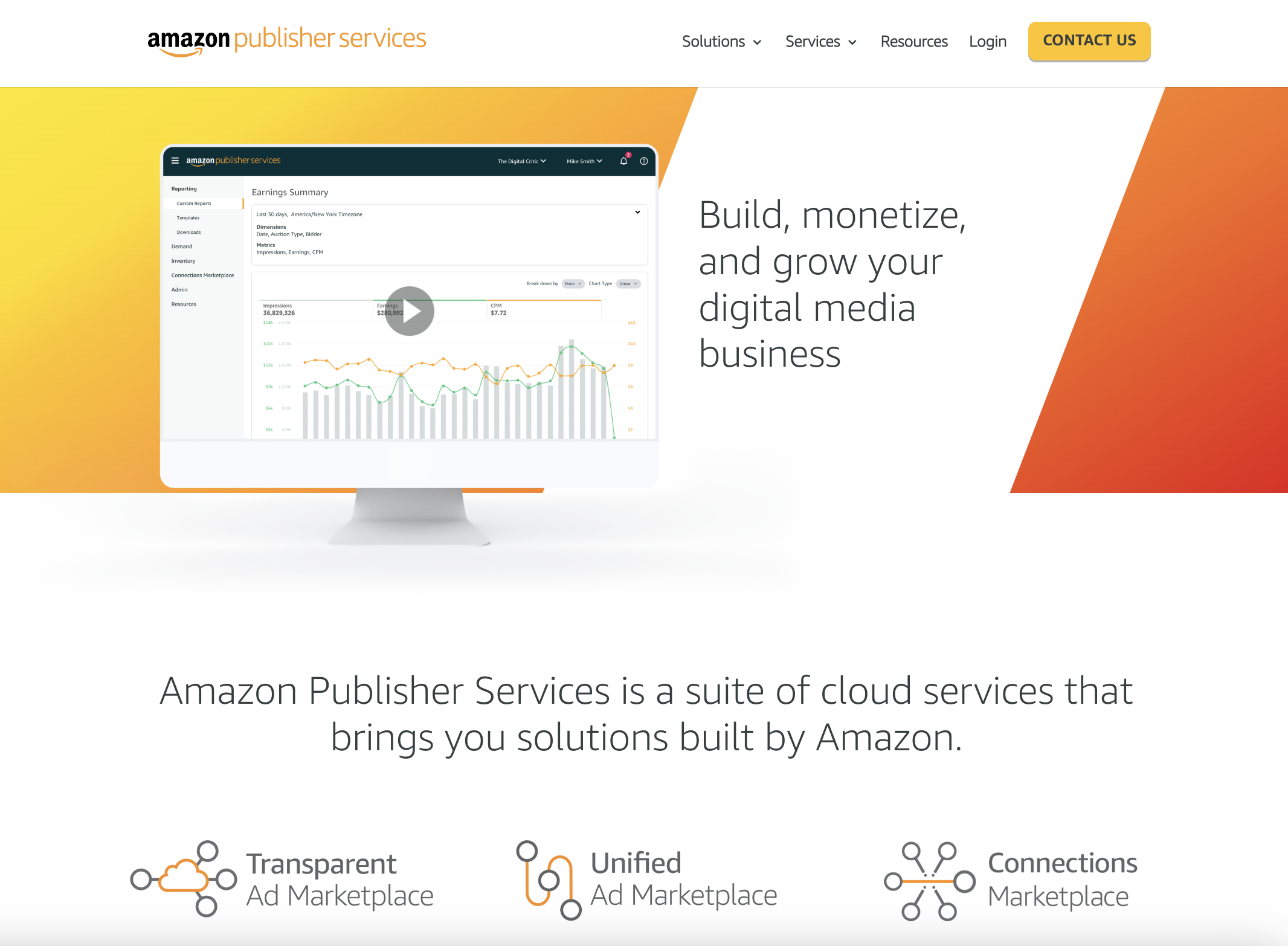 Screenshot from Amazon Publisher Services, October 2023
Screenshot from Amazon Publisher Services, October 2023Amazon Publisher Services equips publishers and content creators with a suite of tools to help them manage their ad inventories and monetize their content.
It offers access to Amazon’s massive advertising ecosystem and its cloud-based solutions like transparent ad marketplace, unified ad marketplace, and shopping insights – not to mention publishers can tap into Amazon’s high ad demand.
On the downside, Amazon Publisher Services is more limited to bigger creators with high website traffic, as it requires a minimum of 5,000 unique website visits daily. It can also be intimidating for newcomers, as it’s more complex than some networks, and implementing it can take time and technical knowledge.
Revenue share: Undisclosed.
Payment model: CPM.
Traffic requirements: 5,000 unique daily visits.
Key features:
- Transparent ad marketplace (TAM) – Amazon’s server-side header bidding solution takes a cloud-based approach, which improves speed and efficiency.
- Unified ad marketplace (UAM) – Enables creators to manage multiple demand partners and get the best bids for their inventory by consolidating demand across sources.
- Shopping insights – A unique feature highlighting data based on shopping behaviors so publishers can optimize their delivery strategies.
6. PropellerAds
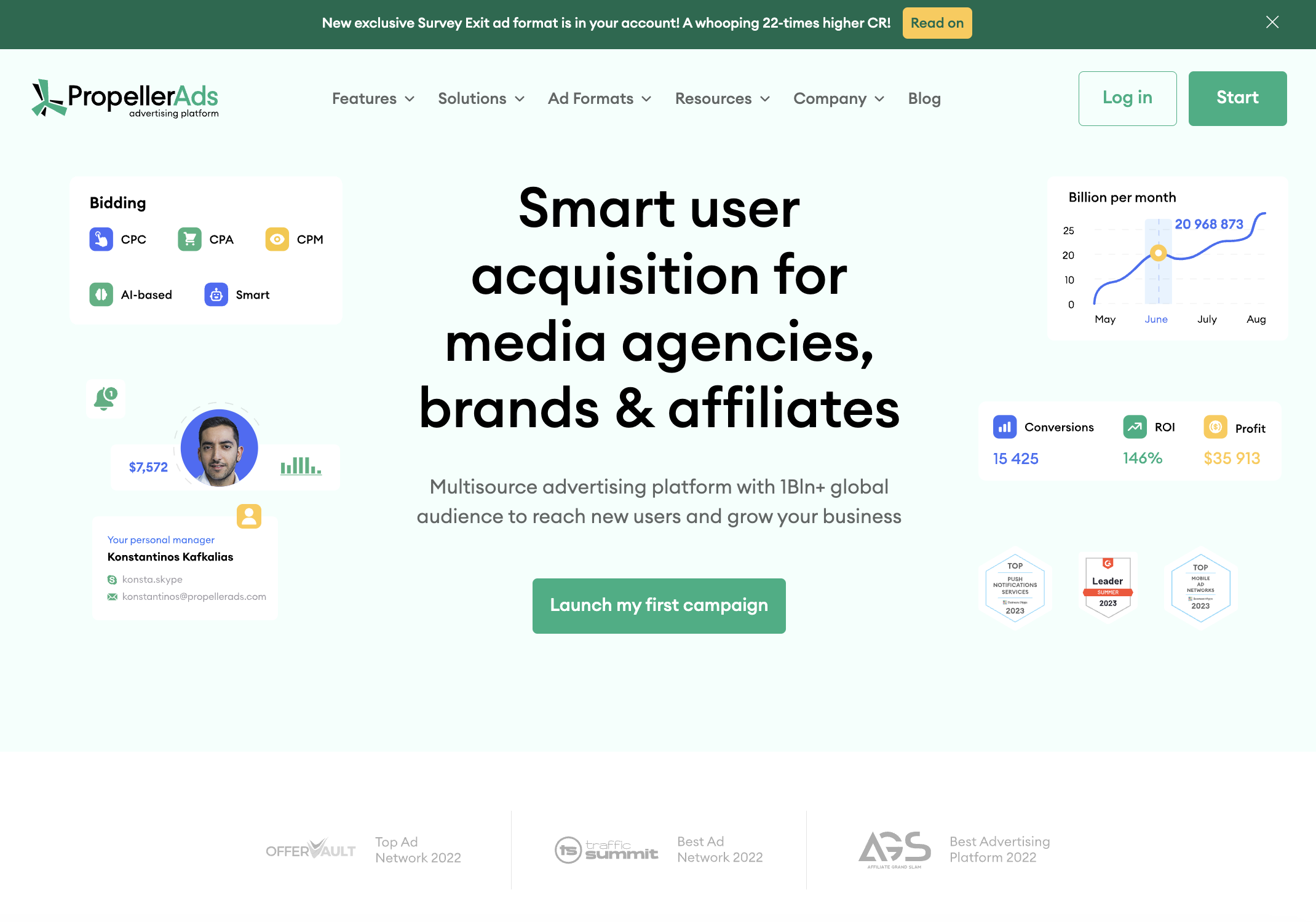 Screenshot from PropellerAds, October 2023
Screenshot from PropellerAds, October 2023PropellerAds is a beginner-friendly ad network that primarily focuses on display ads. It has a user-friendly interface and is easy to join, with no minimum traffic threshold.
PropellerAds offers a global reach and advertiser pool that allows publishers from many regions to benefit from its monetization options, as well as a diverse range of ad formats ranging from popunders to push notifications, native banners, interstitials, and more.
It also uses technology and manual reviews to monitor the quality and content of ads so that its team can remove any unsafe or suspicious content and show the right ads to the right people.
Other pros of PropellerAds include a 100% monetized inventory, flexible payment options, account manager assistance, and optimization tools.
On the other hand, PropellerAds is said to be quite lax with advertisers, which can lead to concerns about low-quality and intrusive ads. It’s also largely limited to display ads, which is worth noting for some.
Revenue share: Undisclosed.
Payment model: CPM, CPC, CPA, CPI, and CPL.
Traffic requirements: None.
Key features:
- Real-time reporting – So you can instantly track the performance of your ads.
- Account manager – Though limited to larger publishers, creators can benefit from a dedicated account manager to help with concerns.
- Referral program – Enables users to generate more cash by referring their creator peers to the network.
7. Infolinks
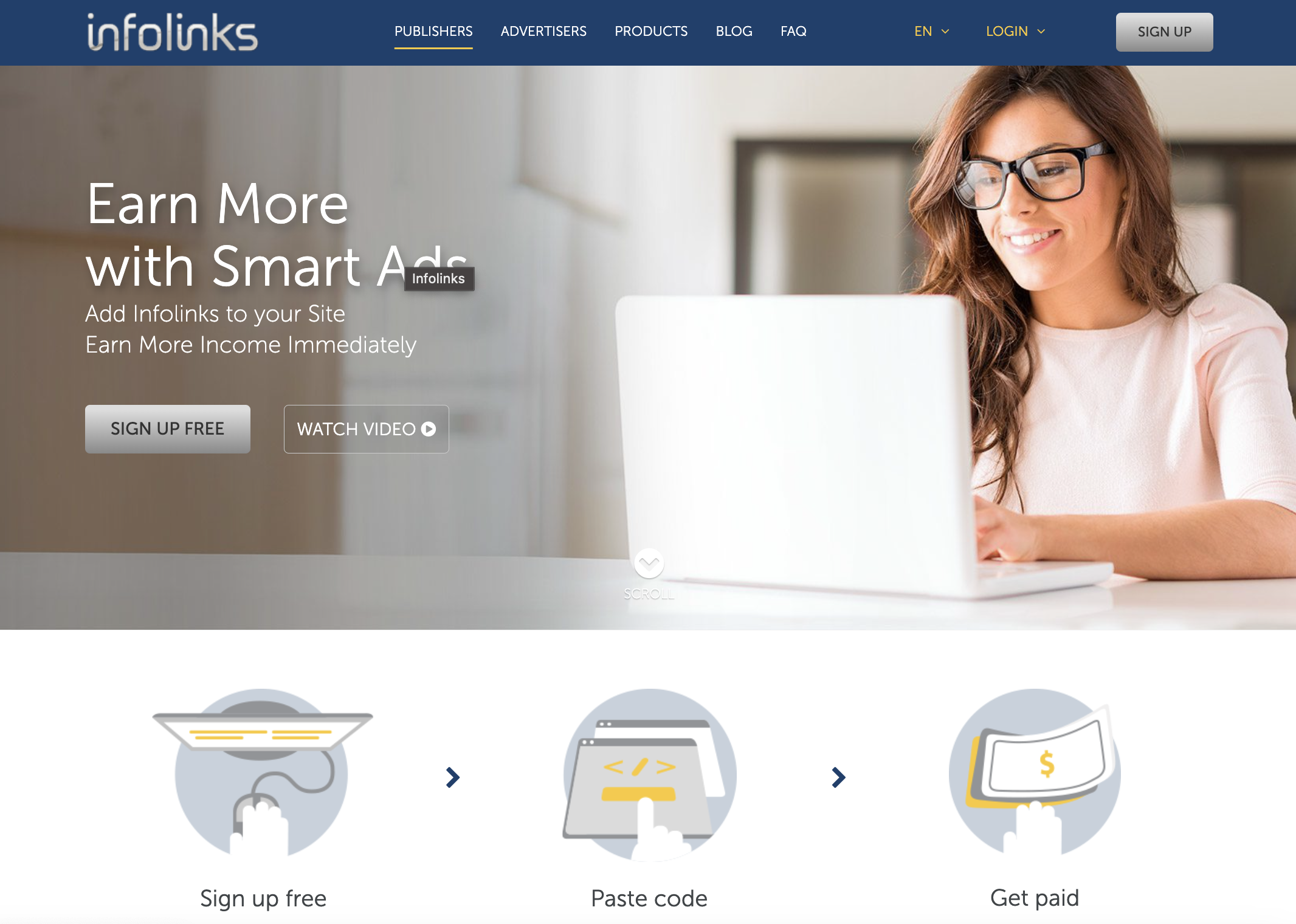 Screenshot from Infolinks, October 2023
Screenshot from Infolinks, October 2023Infolinks is an ad network that works with some of the world’s biggest advertisers, including Amazon, Microsoft, and eBay.
The network specializes in innovative, “intent-driven” banner ad formats that are designed to integrate seamlessly with website content and counteract banner ad blindness. These ad types include InFold, InText, InTag, InFrame, and InScreen ads.
If you’re looking to supplement traditional banner ads or for an alternative, Infolinks might be a good fit for you. It has no minimum traffic requirements, so creators of any size can get on board, and the setup is straightforward.
In addition, you can use Infolinks ads on the same website as AdSense ads, which means you can use them in tandem to boost your income.
The main downside of Infolinks, as with many ad networks, is the potential impact on your users’s experience. Though its non-traditional formats are not as bothersome as big banners or pop-ups, they can still detract from the user experience.
It’s also worth noting that Infolinks has a $50 minimum payment threshold, fairly limited customization options compared to some platforms, and may not have as high an earning potential as other networks.
Revenue share: 70% to publishers / 30% to Infolinks.
Payment model: CPM, CPC, CPA, CPV, CPI, Auction.
Traffic requirements: None.
Key features:
- InText – An ad format that scans content and highlights relevant keywords. When hovered over, these keywords display an ad.
- InFold – These overlay ads often appear as a footer ad in relation to search intent.
- InTag – This ad type pulls your content’s most valuable keywords together into a tag cloud somewhere on the page. When users hover over a keyword, they see relevant ads.
- InFrame – These are banner ads that appear in the margins of your website’s page, using previously unused screen space.
8. Monumetric
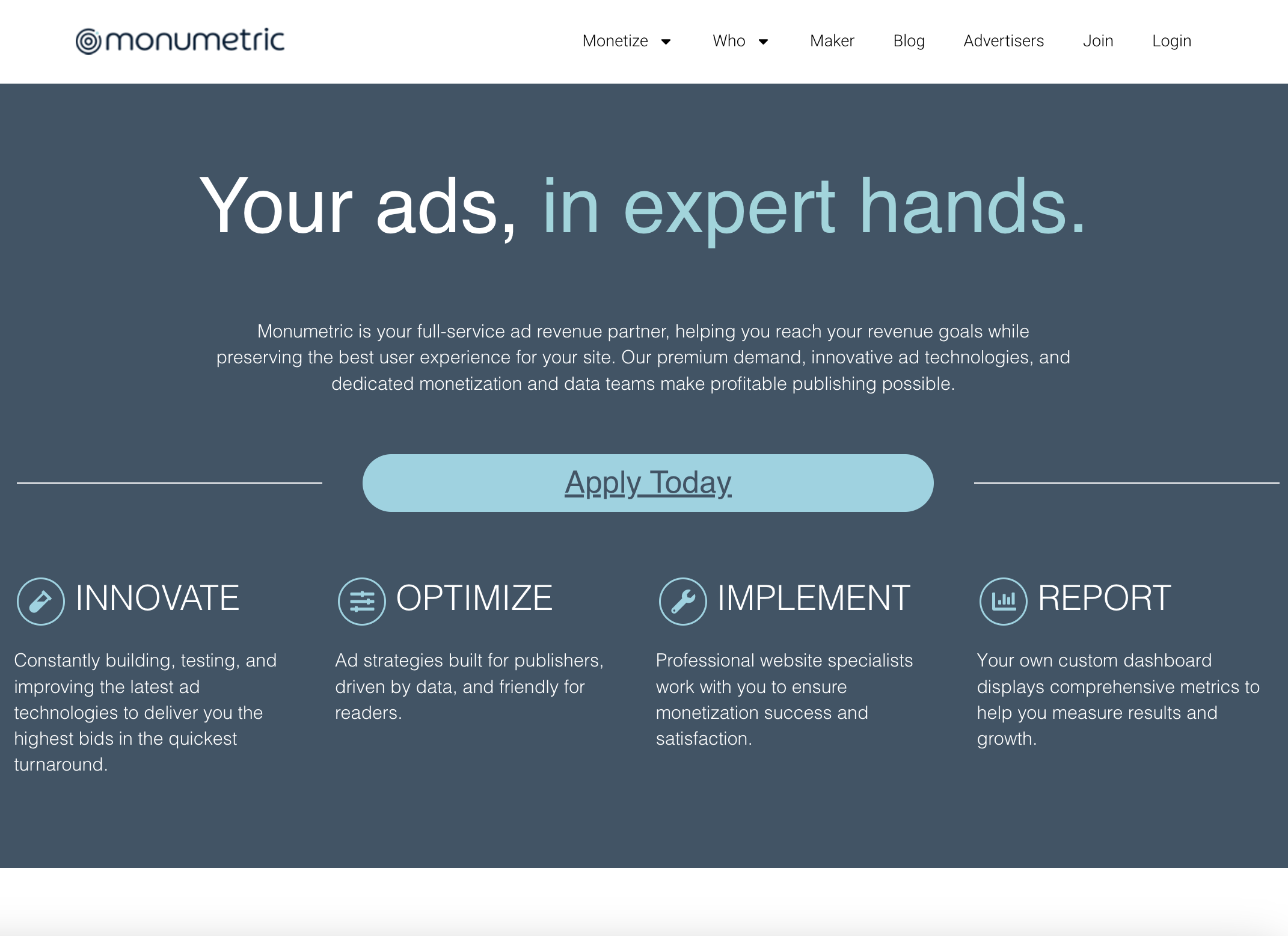 Screenshot from Monumetric, October 2023
Screenshot from Monumetric, October 2023Previously known as The Blogger Network, Monumetric is a wonderful option for publishers that can meet the minimum traffic requirements of 10,000 pageviews per month.
Monumetric boasts a substantial pool of advertisers and offers high earning potential with a wide range of ad formats to choose from, so you can make the decisions that make the most sense for your audience and content.
Another pro of Monumetric is that it’s dynamic; rather than serving a single static ad to a user per session, it will keep delivering different relevant units based on the audience.
Perhaps the biggest draw, though, is the personalized service Monumetric offers to content creators, bloggers, and publishers that use its services. The Monumetrics team provides support to understand your goals, help you come up with an ad revenue strategy, and then even set it up for you.
The cons? Aside from the minimum traffic requirements, there is a one-time setup fee of $99 to join Monumetrics (though this is removed if you have over 80,000 monthly pageviews).
There is also a net-60-day payout schedule with a minimum payout of $10. Perhaps the most important to consider: It only supports WordPress and Blogger websites.
Revenue share: Up to 70% to publishers.
Payment model: CPM.
Traffic requirements: 10,000 pageviews per month.
Key features:
- Dynamic ads – Monumetric provides dynamic ad placements based on the audience and content itself.
- Managed ad platform – The company offers hands-on support and will handle the placement and management of your ads for you.
- Personal support – One-on-one attention with the Monumetrics team, who will help you build out a custom ad strategy for your blog.
9. Taboola
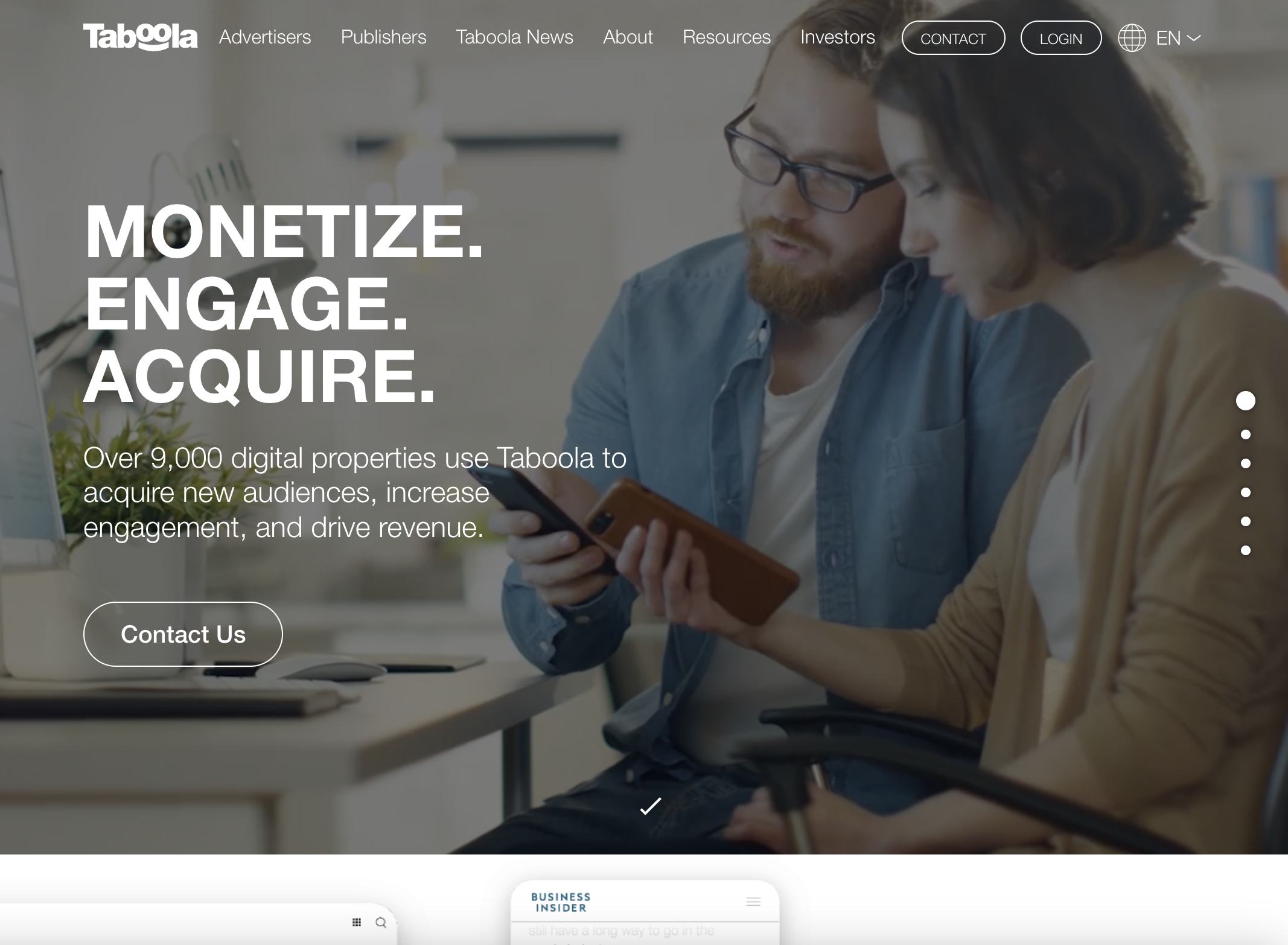 Screenshot from Taboola, October 2023
Screenshot from Taboola, October 2023Taboola is a leader in the content recommendation and suggestion space. What is that, you might ask?
Have you ever read a blog or article and encountered a section at the bottom recommending other articles you may like from external sources? These are native ads (also known as sponsored links), and they are typically placed through an ad network like Taboola.
By signing up for Taboola, publishers and creators allow the network to serve ads through native content suggestions, whether they’re articles or videos.
The benefit of this type of advertising is that it’s designed to blend in with your site’s content and provide a more organic user experience rather than a disruptive banner ad.
You can filter what types of content can be shown to your audience, and Taboola offers easy setup and very high earning potential.
The biggest downside to Taboola is that it has a very high minimum traffic requirement to sign up; you must have at least 500,000 pageviews on your blog each month to qualify. If you don’t hit that threshold, you’re not alone.
If you do qualify, you should know that some of the content suggested on your site may not feel like the right fit or could look like spam.
Revenue share: 50% to publishers / 50% to Taboola.
Payment model: CPC, CPM.
Traffic requirements: 500,000 pageviews per month.
Key features:
- Native ad format – Ads are designed to blend in with your site’s content and provide the least disruption to your users.
- User-friendly interface – Taboola’s platform is straightforward and easy to use.
- Content discovery engine – Taboola’s algorithm will choose content recommendations based on the interests of your audience in order to suggest the best content.
10. Revcontent
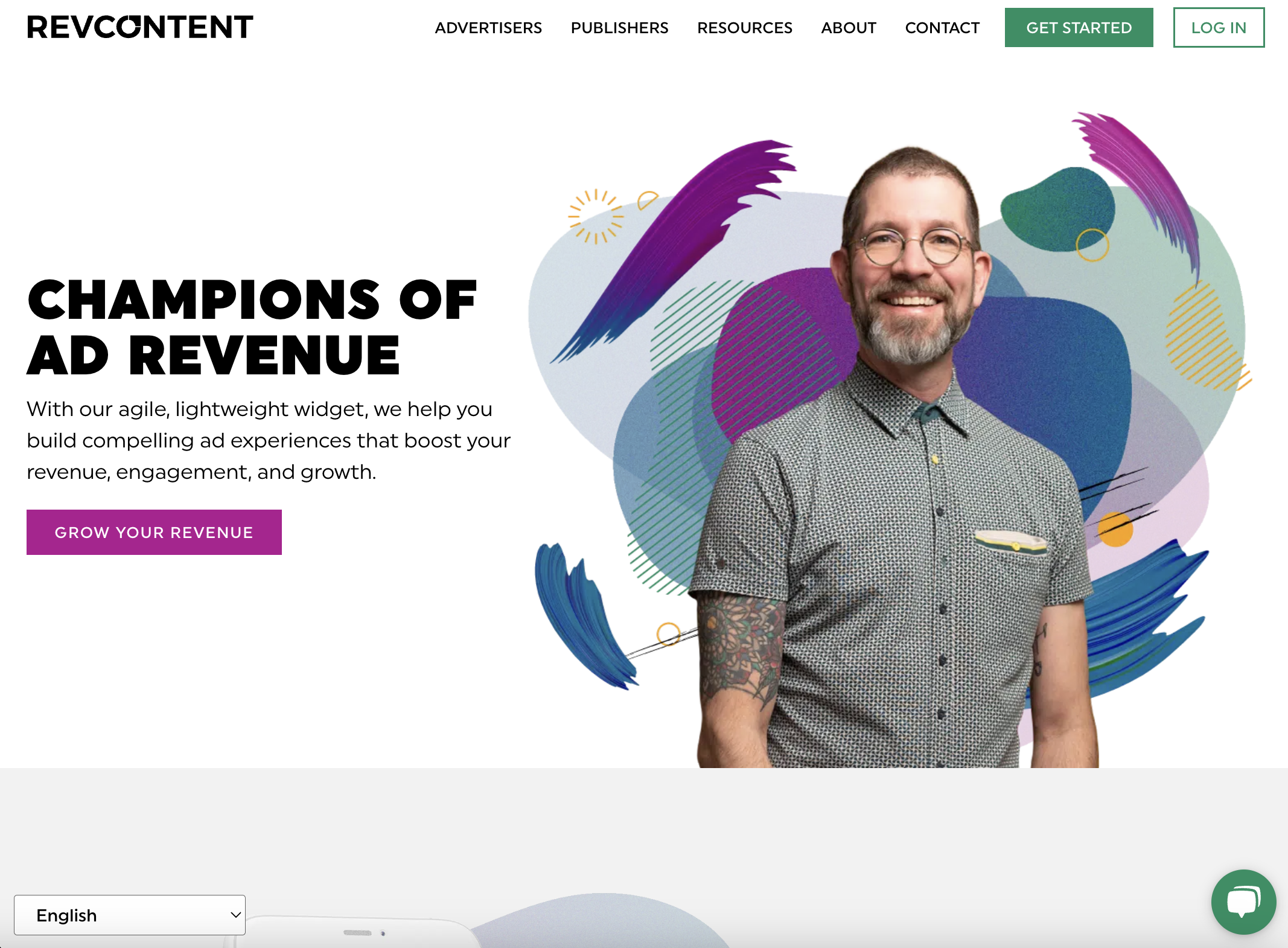 Screenshot from RevContent, October 2023
Screenshot from RevContent, October 2023Interested in getting into the content recommendation space, but don’t meet Taboola’s minimum traffic requirements? Check out Revcontent!
With a minimum requirement of 50,000 pageviews per month, Revcontent is a much more achievable option for bloggers and content creators. And while it’s smaller in scale than Taboola, it is still a strong competitor with a focus on performance and quality.
Revcontent offers unique customization options for publishers, so you can ensure that the native ads showing up alongside your content align with your site’s design and branding.
It also offers multiple different options for placements – from the bottom of your blog posts to your newsletters or even video ads.
The network is known to have a fairly strict approval process, which means you can expect quality content and placements that make sense.
The cons of Revcontent are that, despite having a much lower minimum monthly traffic requirement to join, you still need to have a decent amount of traffic to hit that threshold. On top of this, the approval process can be challenging for some.
As mentioned above, it’s not as far-reaching as its larger competitors, Taboola and Outbrain. And it has a minimum payout of $100.
Revenue share: 80% to publishers / 20% to Revcontent.
Payment model: CPC, CPM.
Traffic requirements: 50,000 pageviews per month.
Key features:
- Widget customization – To allow publishers the ability to customize what appears on their site.
- Content recommendation technology – A proprietary algorithm that ensures recommendations are relevant and engaging.
- Viral content discovery – Do you think a particular piece of content might go viral? Revcontent offers the ability for publishers to promote content that has the potential to go viral so you can maximize your revenue.
11. BidVertiser
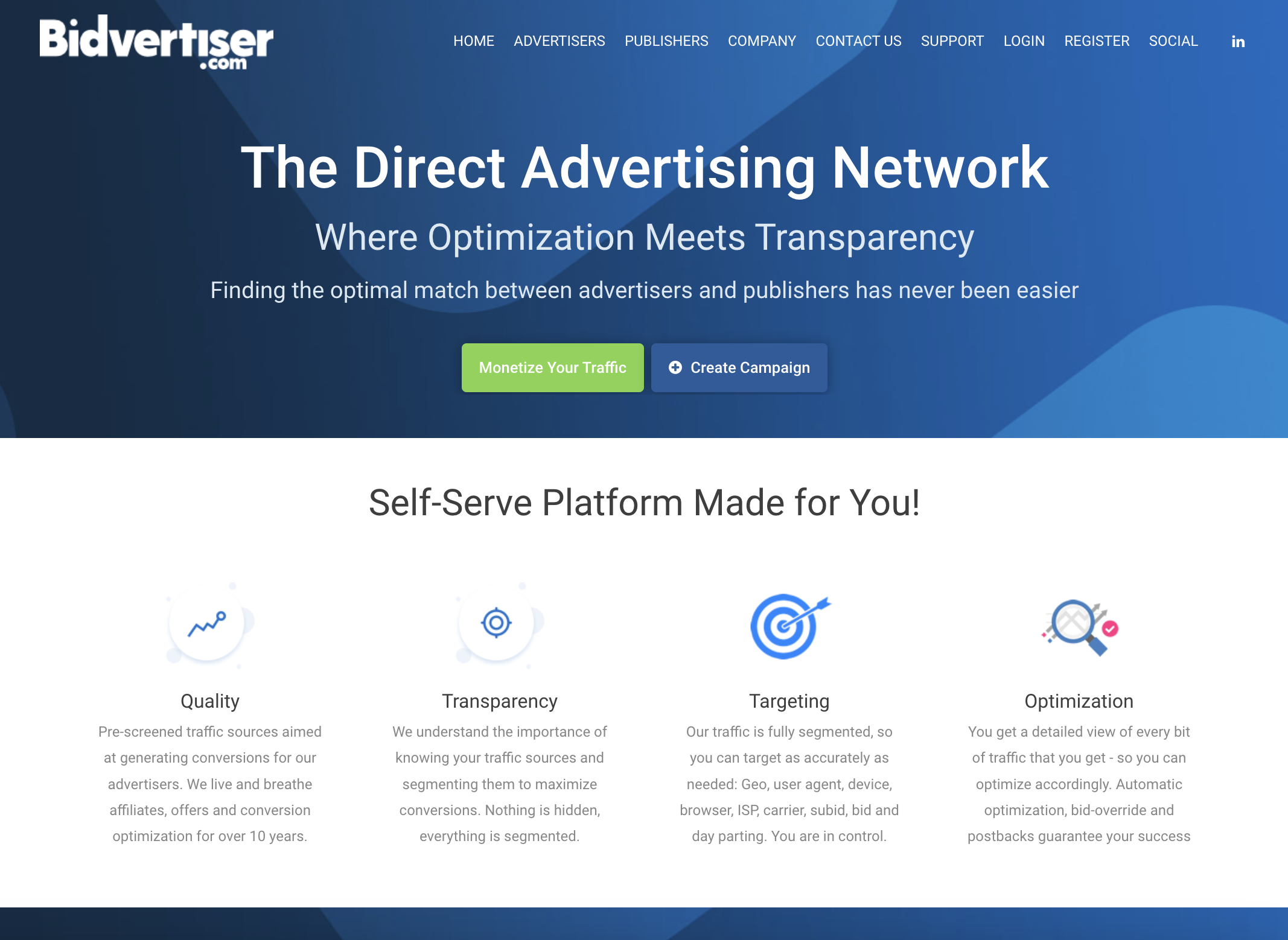 Screenshot from BidVertiser, October 2023
Screenshot from BidVertiser, October 2023BidVertiser is a direct advertising network that might be a good choice if you’re looking for choices outside of the major players.
It launched in 2003 and now serves more than 80,000 publishers and advertisers around the world with a variety of ad formats ranging from slider ads to popunder ads and native ads.
With BidVertiser, creators don’t just earn money for clicks on ads. If that click leads to a conversion (or sale for the advertiser), you’ll get even more money in your piggy bank.
It has a low payment threshold of $10, no minimum traffic requirement, and, like Revcontent, BidVertiser provides tools to customize the design of your ad units so that they flow nicely with your own website and content. It also has a 100% fill rate.
What’s more, BidVertiser utilizes an automated approval process. So, if you meet its requirements for joining, you’ll be approved instantly to start generating revenue.
Of course, BidVertiser has its downsides, too.
You may find that some of the ads it serves on your site aren’t exactly relevant to your audience, as it doesn’t use contextual targeting, which can result in lower CTRs.
Also, creators need to provide a list of advertisers they would like to work with, or BidVertiser will simply select them at random.
Finally, while BidVertiser has a global reach, those with non-US traffic might not see a ton of earnings.
Revenue share: Undisclosed.
Payment model: CPC, CPM, CPA.
Traffic requirements: None.
Key features:
- Direct advertising platform – This means that creators and advertisers can connect with each other directly without any middlemen.
- Geo-targeting – Allows publishers to segment their audience based on things like demographics and geography, then show targeted ads to that segmented audience for better revenue generation.
- Transparency – BidVertiser provides creators with details on incoming bids, winning bids, and revenue earned so that you have all the information you need.
12. Mediavine
Mediavine is a favorite ad network among many bloggers and content creators due to its commitment to maximizing earning potential while maintaining a positive user experience for your audience.
Let’s start with the pros.
Mediavine is said to have faster ad delivery than many other ad networks, meaning your users don’t have to wait as long to see your ads. In fact, Mediavine claims its ads load 200% faster than competitors.
It prioritizes the user experience in other ways, too, like website scripts that are optimized for SEO and speed and high-quality ad placements that balance revenue with UX.
It’s known for having some of the highest revenue per mille (RPM) in the industry, a large pool of top publishers and advertisers, as well as a strong community of creators who support each other, learn from each other, and even connect at conferences and events.
As with many ad networks, Mediavine’s major downside is its minimum traffic requirement. Though not as steep as some, you will need a minimum of 50,000 sessions per month, mostly traffic from the USA, in order to qualify.
On top of that, Mediavine requires 100% exclusivity from its publishers, meaning you won’t be able to use other ad networks on your site while you’re working with it.
Revenue share: 75% to publishers / 25% to Mediavine.
Payment model: CPM.
Traffic requirements: 50,000 monthly sessions.
Key features:
- Strong community – Publishers get access to Mediavine’s dedicated Facebook group, where they can network with other industry experts and content creators.
- Dynamic ad placements – Mediavine prioritizes high-quality ads that focus on providing a great user experience and viewability.
- Transparent reporting – Both creators and advertisers have access to detailed insights and analytics through Mediavine, including a dashboard that shows top posts and RPMs.
13. Adsterra
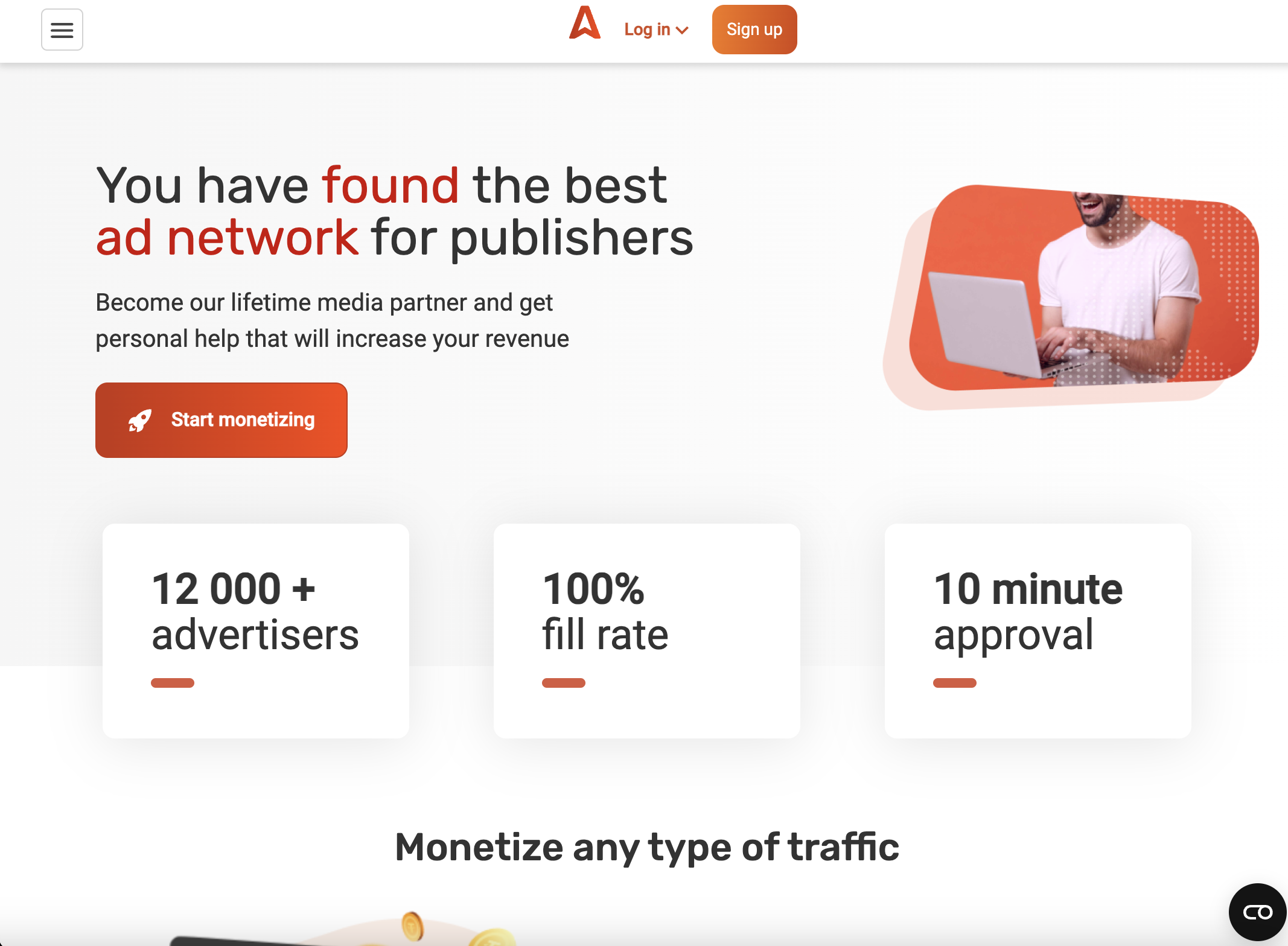 Screenshot from Adsterra, October 2023
Screenshot from Adsterra, October 2023Adsterra is a reputable and reliable ad network with global coverage that many see as a good alternative to some of the bigger networks. It’s especially useful for creators who might be looking for more worldwide coverage and a healthy range of ad types.
Adsterra bills itself as the best ad network for publishers and boasts a 10-minute approval process, a 100% fill rate, and 12,000+ advertisers in its network. And there’s no minimum traffic requirement to join.
It’s a self-serve platform, making it easy to use, and publishers can choose from ad types like Popunder, social bar, in-page push, native banners, and standard banners. You can monetize social and mobile app traffic with Adsterra in addition to your typical desktop and mobile website traffic.
Some other benefits of Adsterra include its three-level anti-fraud system to ensure a safe experience, flexible and tailored payment options, and a Partner Care support system, which offers 24/7 multilingual chat for users.
The downsides? Adsterra has a minimum payment threshold of $100, and CPM rates can vary depending on location.
Revenue share: Undisclosed.
Payment model: CPC, CPM, CPI, CPA, CPL.
Traffic requirements: None.
Key features:
- Referral program – Adsterra offers a referral program to publishers, where you can earn 5% of the revenue generated from anybody you refer.
- Strong security – Leveraging a combination of in-house and third-party fraud detection tools, along with manual human reviews, Adsterra is dedicated to offering first-rate security.
- Customer support – With 24/7 support in multiple languages.
14. Sovrn (Formerly VigLink)
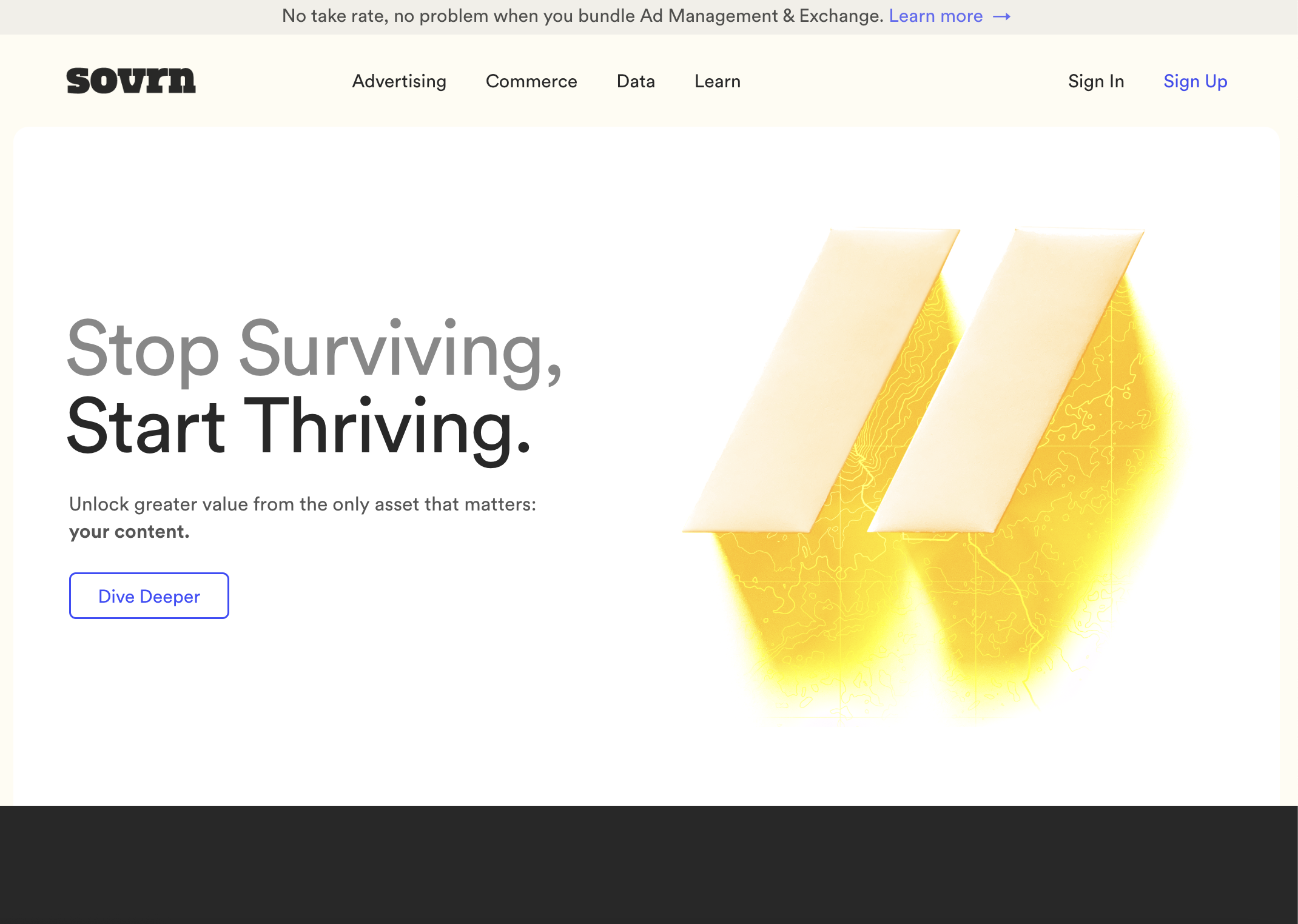 Screenshot from Sovrn, October 2023
Screenshot from Sovrn, October 2023Sovrn is a supply-side platform (SSP) that provides tools and services to publishers and creators to help them monetize their content.
It combines more traditional ad-serving techniques with methods like automated affiliate linking (powered by VigLink, a company acquired by Sovrn).
Sovrn creators get access to what it calls the Sovrn Data Collective, the “world’s largest publisher collective for deep consumer insights and enriched audience data.”
Sovrn serves over 60,000 sites and includes offerings like an ad exchange, ad management, and more.
It’s easy to set up Sovrn’s tools and integrate them with your website, and it can automatically convert your relevant links to affiliate links – even on older content. It offers a variety of ad formats that you can customize based on your audience.
While there are no minimum traffic requirements to join Sovrn, there is a minimum payout threshold of $25 ($50 for wire transfer) and a fairly strict approval process. It also has a net-60 payment structure.
Revenue share: 75% to publishers / 25% to Sovrn.
Payment model: CPM, CPC, CPA.
Traffic requirements: None.
Key features:
- Signal – Sovrn’s Signal feature enables publishers to take a closer look at their audience’s behavior and use those insights to customize their ad units.
- Automated affiliate conversion – Previously known as VigLink, this feature allows you to automatically convert standard links to affiliate links.
- Access to Sovrn Data Collective – Publishers can tap into data from across Sovrn’s collective to understand what ads audiences are consuming and responding to in order to generate maximum revenue.
15. BuySellAds
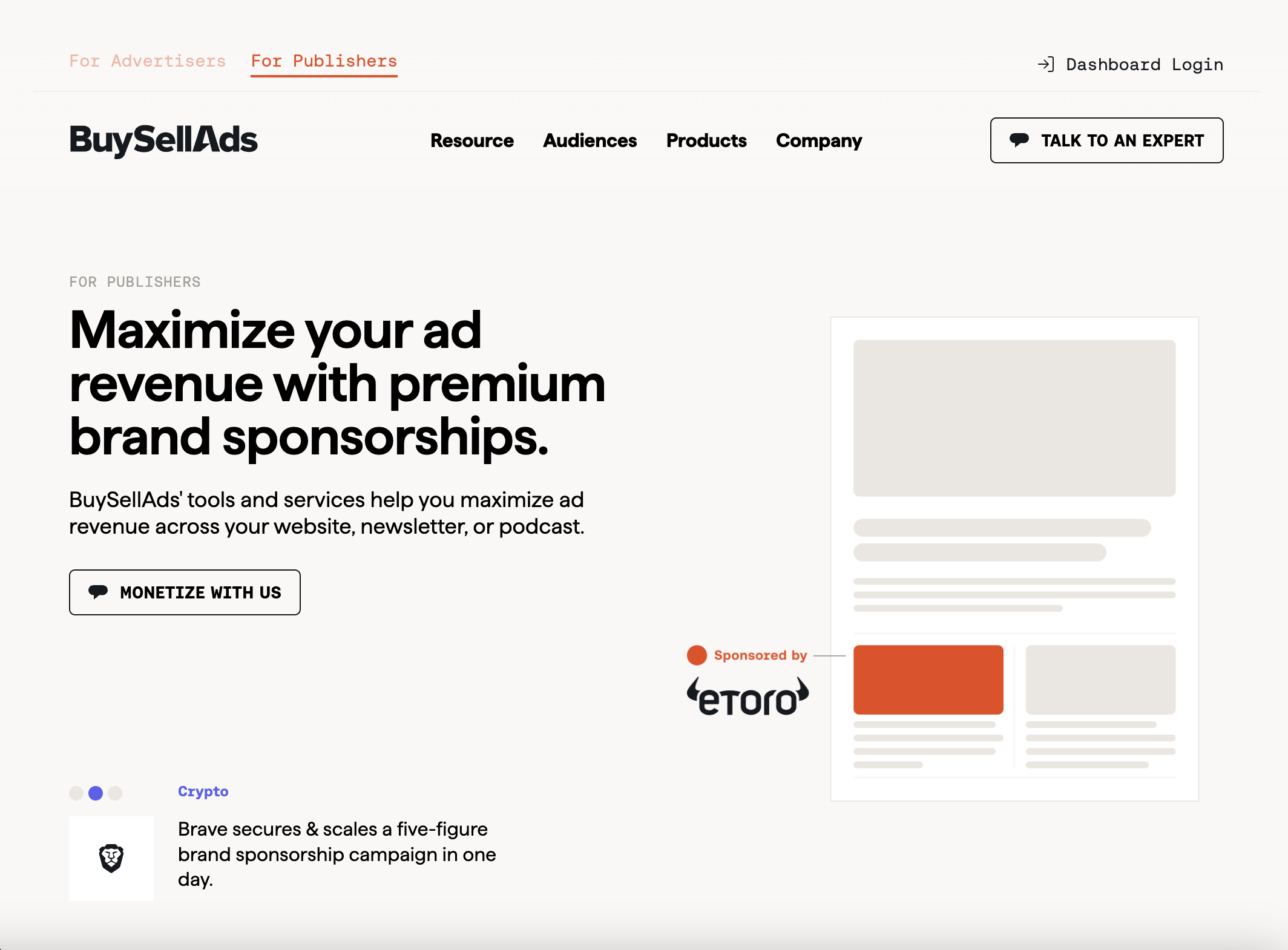 Screenshot from BuySellAds, October 2023
Screenshot from BuySellAds, October 2023BuySellAds is an ad marketplace that helps publishers generate revenue by connecting them directly to advertisers. Creators can monetize websites, newsletters, and even podcasts with BuySellAds.
Here’s how it works: BuySellAds enables publishers to list their available ad inventory and CPM in a central marketplace, where advertisers can submit bids for those ad placements.
Creators then get to review the advertiser’s proposed creative – and once approved, the ads will begin running on your site.
BuySellAds boasts an easy-to-use platform, non-disruptive ad types, contextual brand sponsorships that are aligned with your content, and a reliable payment schedule.
The cons worth noting are that there’s a bit of a learning curve when you first get started, and there are some minimum payment thresholds, ranging from $20 for PayPal all the way to $500 for wire transfer.
Revenue share: 75% to publishers / 25% to BuySellAds.
Payment model: CPM.
Traffic requirements: None.
Key features:
- Range of products – Creators can monetize not just their websites, but also newsletters and podcasts.
- Pricing control – Publishers have the ability to set their own rates through BuySellAds, which gives them more control over their earnings.
- Marketplace – BuySellAd’s marketplace enables publishers and advertisers to connect with each other, ensuring that ad placements make sense for both parties.
16. Ezoic
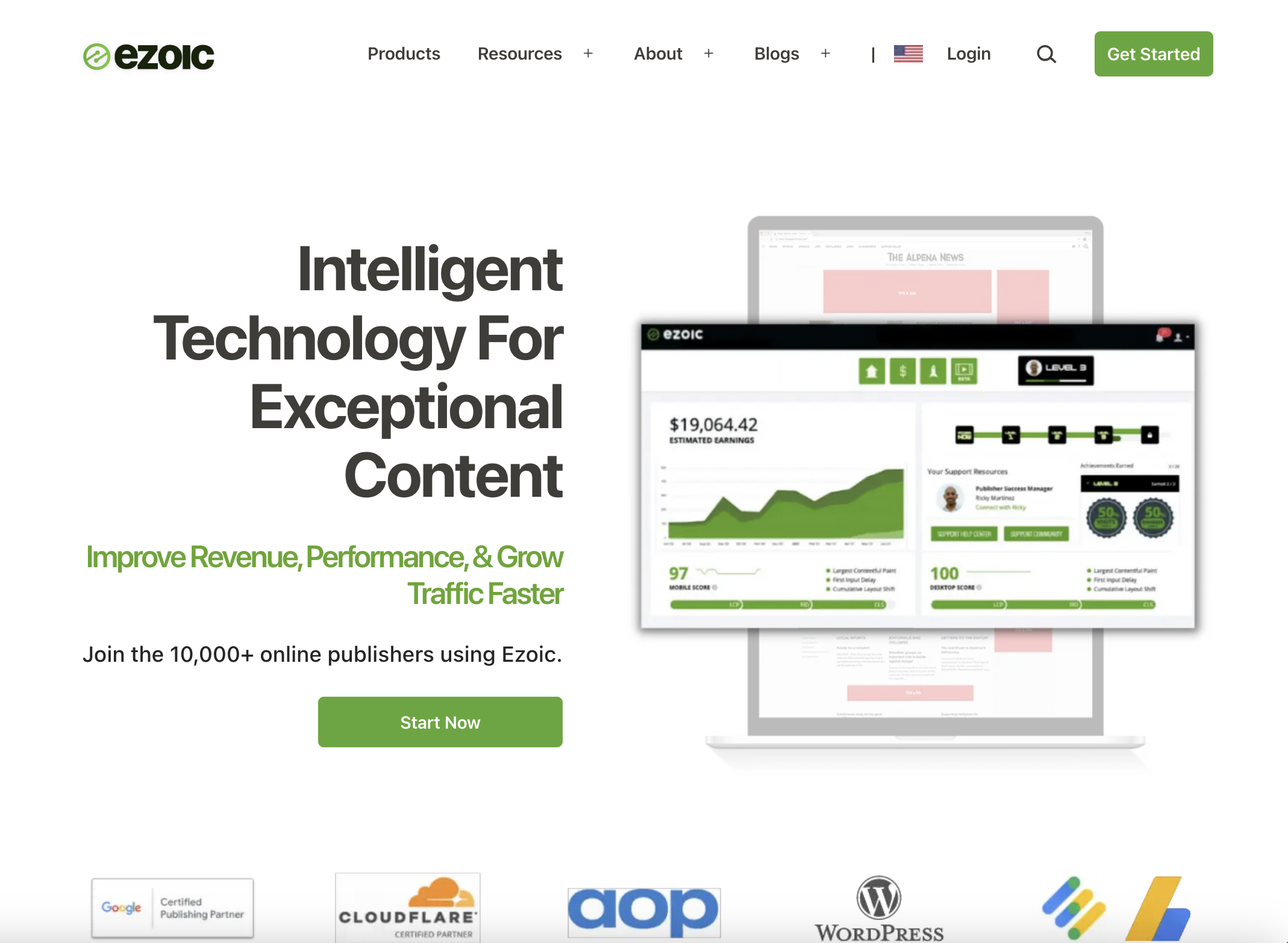 Screenshot from Ezoic, October 2023
Screenshot from Ezoic, October 2023Ezoic is a technology-driven ad network that leverages AI to help publishers get the most out of their ad placements and drive increased revenue.
Given that Ezoic is a Google Certified Publishing Partner, creators can be sure it adheres to industry standards when choosing how to serve ads on your website.
It claims to be the first solution in the industry to incorporate AI and machine learning into its features, and it uses these to test different ad placements, formats, and sizes to figure out the best formula for publishers to boost earnings while providing a great UX.
With Ezoic, creators can select placeholders to delineate where they want to serve ads on their site or even identify user experience metrics they care about (e.g., page load time), and Ezoic’s AI will consider this when determining how to serve ads to your audience.
It has no minimum traffic requirement to sign up, and it caters to global traffic – so you can make money even if your traffic isn’t all from the US.
However, you’re unlikely to earn a ton unless you have US traffic. Also, you might experience a learning curve as you get up to speed with Ezoic’s tools and features, and some temporary performance issues as Ezoic experiments with different layouts and placements to select the right one.
Revenue share: 90% to publishers / 10% to Ezoic.
Payment model: CPM, earnings per thousand visitors (EPMV).
Traffic requirements: 10,000 monthly visitors.
Key features:
- Mediation – Ezoic’s Mediation feature allows publishers to integrate and manage multiple ad networks (including Google AdSense) alongside Ezoic and lets them compete for ad inventory. This ensures creators can get the highest possible bids every time.
- Leap – An exclusive toolset that provides creators with insights and tips to help enhance speed metrics, page load times, and Core Web Vitals scores.
- Humix – An innovative video tool that enables creators to share and display videos from other publishers on their own website.
17. RevenueHits
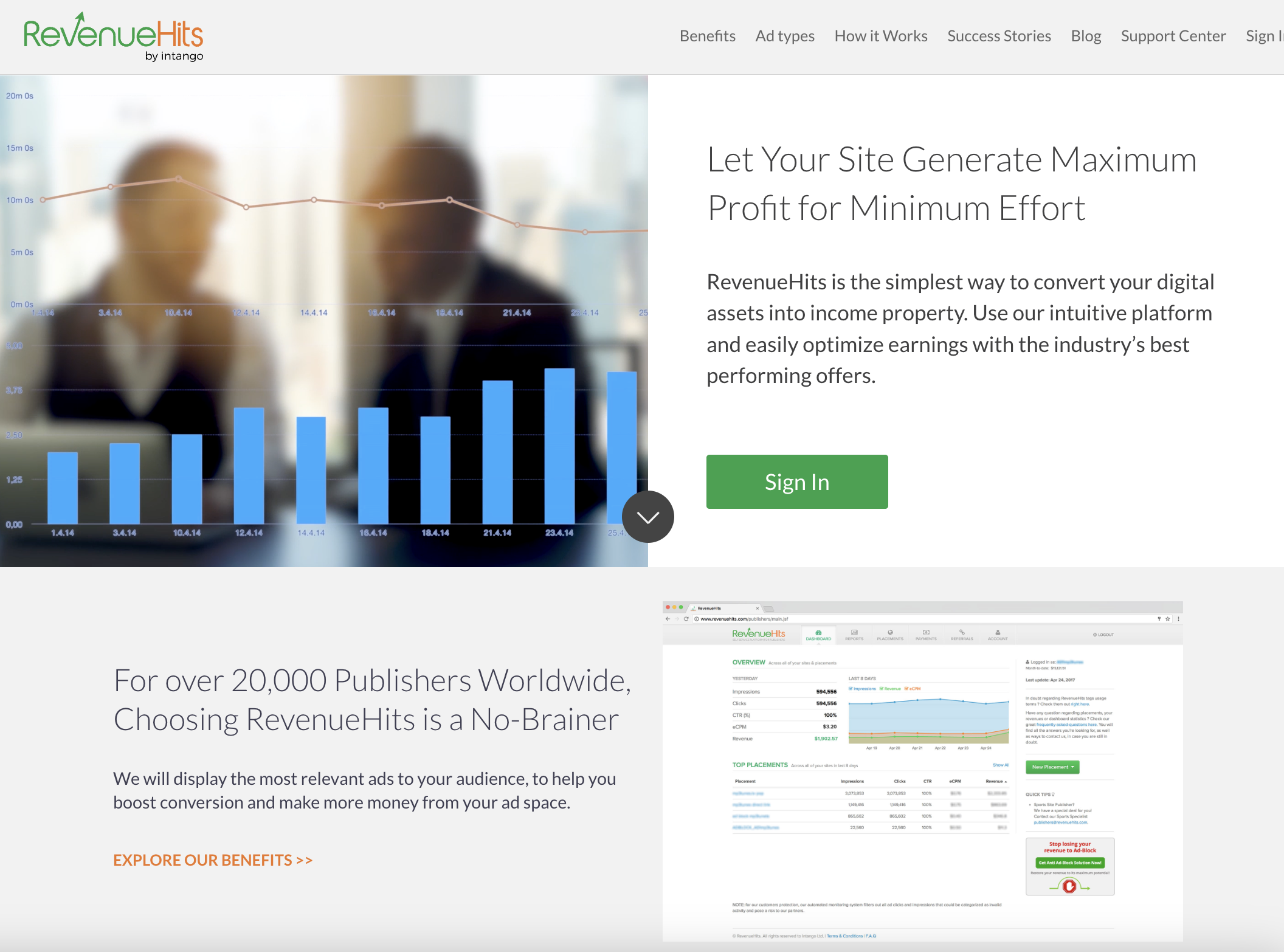 Screenshot from RevenueHits, October 2023
Screenshot from RevenueHits, October 2023RevenueHits is a self-service, performance-driven ad network that’s a great fit for creators with high-intent audiences that are likely to buy.
For the most part, RevenueHits leverages a performance-based model, which generates income based on cost per action (CPA). This means that if a user clicks an ad on your site and converts by making a purchase or a sign-up for the advertiser, you make money.
There’s no minimum traffic requirement to sign up, and with payouts of up to $50 per acquisition, there’s a high earnings potential.
However, conversions are much harder to achieve than clicks or impressions. So, if you don’t have a high-intent audience that actually takes action on ads, you’ll probably see inconsistent earnings, which could be lower overall than a CPM model.
There’s also a minimum payment threshold of $20 for PayPal and $500 for wire transfers. It also doesn’t have the same reputation for high-quality ads that prioritize user experience that other ad networks in this list do.
Revenue share: Undisclosed.
Payment model: CPA, CPL, CPM.
Traffic requirements: None.
Key features:
- CPA model – Publishers receive payments based on when their users make a defined action – whether that’s a sale, sign up, registration, form fill, or other.
- Range of ad formats – Including but not limited to display banners, shadow box, floating banners, footer sticky, in-page push, and more.
- Referral program – Enables creators to refer other publishers and earn up to 10% of their earnings for a year.
In Summary
For content creators, bloggers, and publishers, choosing the right ad network can be a challenging task.
From understanding the nuances, pros, and cons of each platform to deciphering their various payment models and methods, there’s a lot to consider.
The key, though, is to make sure the platform(s) you choose to align with your content goals and values.
You should know what matters most to you going into it – whether it’s the quality of ads, user experience, or payout frequency – and make sure that it is reflected and prioritized in the ad network you choose.
Whether you’re a brand new blogger taking the first steps to monetize your content or a seasoned creator reevaluating your revenue strategy, we hope this guide can help you make informed decisions and maximize your earnings.
More resources:
Featured Image: Anton Vierietin/Shutterstock
